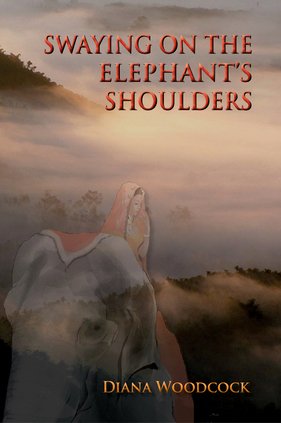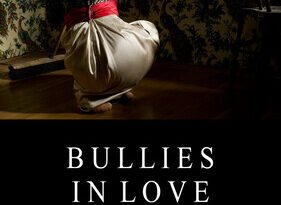Swaying on the Elephant’s Shoulders
By Diana Woodcock
($18.95, (7” X 10”) Paperback, 152 pages, with 50 b&w photos)
Swaying on the Elephant’s Shoulders by Diana Woodcock, is a remarkable collection expressing a three-fold concern for human rights, refugees, and ecology. It is a celebration of life, a protest against violence and greed, and an exploration of humanity’s relationship with and interdependence upon nature and fellow human beings.
Winner of the Vernice Quebodeaux Poetry Prize
INTRODUCTION
The Grace of Gentleness
In his remarkable book on shamanistic healing, Alberto Villoldo points out that a crucial initiation for central figures in the major religions requires a retreat from the world to achieve illumination. Jesus, Buddha, Mohamed all emerged enlightened through meditation and isolation. Somehow the silence and stark beauty of the desert enabled them to rediscover the world and reclaim it with spiritual authority. Diana Woodcock is another voice singing to us from the wilderness of Qatar, translating the world for us, calling us to a higher order, and like Adam and Eve in the garden, tasked with naming the bright world so that we may own it.
When I began the introduction for this manuscript, my heart sank a bit when I read, “Swaying on the Elephant’s Shoulders expresses a three-fold concern for human rights, refugees, and ecology.” I have been trained to believe that poetry usually fails to the exact extent it attempts to preach or instruct. There are notable exceptions, of course, such as Robert Bly’s anti-war poems, or Muriel Rukeyser’s early feminist poems (and those of a generation of female poets that came out from underneath her coat, as it were, like Maxine Kumin, Adrienne Rich and Dianne Wakoski to name a few,) and gay poets from Whitman to Ginsberg.
The subject of poetry, of course, is everything—human or divine, but how one treats the subject defines the art of poetry. And a reader who picks up a collection of poems, which has won an “international poetry prize for women,” maybe a little wary. Is the criteria to be poems written by women or poems written about women? Does the sex of the poet qualify the contestant or the philosophy of the poet writing about women? Most women no longer accept the term “poetess….” In any case, there are many fine poems that treat women’s issues with a deft hand, one of the best of which is “Footbinding.” It is a beautifully understated indictment of this practice and the Chinese treatment of female children, ending ironically with a young granddaughter squirming to squeeze herself into dresses several sizes too small.
I’m mostly with Valerie who holds that one makes poetry with images, not ideas, however. And Woodcock seems to be in this camp as well when she quotes Marilyn Chin in an epigraph to one of her poems:
“The poet guards the conscience of society–
no; you’re wrong; she stands lonely on that
hillock observing the pastures.”
It is this talent for observation that is one of Woodcock’s most striking qualities. And throughout the poems, she is consciously aware of her role as an observer. In “Survivor,” which Mark Strand selected for inclusion in Best New Poets 2008, she describes, “Five cormorants on the decaying pier allowing me to watch them watching for fish, shadows under shadows on the water.” Interestingly, the reader becomes a participant in the game, observing her observing the cormorants observing the fish. One thinks of a Renaissance master playing with perspective when he paints and we observe a woman looking through a window onto a courtyard, which leads to a view of the valley below.
In “Hakeem’s Farm,” she expands her insight into observation when she says, “Always a strange sensation: awareness of the making of a memory.”
The ability to stand outside oneself and observe the world with compassion comes from the practice of meditation which seems to be an integral part of Woodcock’s spiritual discipline and cultural background. Throughout the poems, she strives for such enlightenment and alludes to Buddhist practice. In “Choosing a Desert,” she offers a signpost for a world-weary pilgrim:
“In the silence and solitude, you’ll learn to
love your neighbor for who he is – not
for what he says or claims to be. In this harsh
place, you’ll find within yourself the grace of
gentleness.”
Woodcock does not don the habit of a Buddhist nun, though she seems to be a secular acolyte to our Lady of Sorrows. The desert is “…the place to enter the cloister of your own/design – take all the time you need to simply be.”
Swaying on the Elephant’s Shoulders is the journal of a soul who has not given up, who finds the world awesome in the truest sense of the word. She is not a saint – this book prize does not aim to canonize her, but she has not given up hope and continues to relish the beauty of the bright world, despite the horrors humanity persists in concocting. She hasn’t grown cynical, is trying simply to be a good person, to understand, and forgive in the context of life’s great moral complexity, a good example of which is the extraordinary poem, “The Pol Pot Soldier Tells His Side.” Because he realizes his comrades will cut out his heart and force his victim to eat it, he butchers the pregnant woman to prove and save himself. After such troubling gore in the poem, the last stanza ends with a stunning, understated, surrealistic image:
“We left them there
under a camphor tree.
I was the one who looked back–
My compatriots had their stomachs set
on finding crayfish for lunch.
I saw the dead woman rise up
to cradle her infant; glancing up
from eating my heart, she looked at me
with my mother’s eyes.
It’s hard to think of a poem that uses motherhood to greater effect in describing the fog and horror of war.
These poems are heartfelt, but Woodcock does not wear her heart on her sleeve. The poems take rise in a lyric impulse, but she realizes that a poem is a well-crafted object, as well as a cry from the heart. Woodcock transforms “raw” emotion into what T. S. Eliot calls artistic emotion, re-creating the original emotion in the reader through metaphor and the music of poetry. She is a good example of the new formalism and in the collection, the reader will find many traditional forms such as the Ghazal, the Sonnet, Haiku, free verse, and concrete poetry. In one surprisingly successful experiment, she re-tells the same poetic subject in three different poetic forms. In a deceptively simple poem, “Macau Teahouse” she sits among the old men drinking tea, honing her craft, sure there wasn’t anywhere she’d rather be:
“Sharing a table with canaries
and old men, I would consider modulation,
music and meaning while marking stresses
and counting syllables on my fingers. They
meanwhile, would debate ruthlessly
whose bird was truly the sweetest heard.”
After more charming detail on life in the cafe, the final line, “Why did I ever leave” hits the reader with an impact similar to the famous stark dictum that ends Rilke’s poem on Appollo: “You must change your life.”
In one of the many poems in which the poet visits a temple, we hear a Taoist recluse playing a bamboo flute. A lotus pond, the Chestnut Moon, draw her in. In the sky,
“Fungi rose up from decaying
cumuli, elixir-bound.
Sounds of three rivers converging
and metal chimes merging
the portions of the day
urged me to stay in seclusion,
to leave behind every illusion
of secular life.”
The poem ends almost as a lullaby:
“Crickets crouch
at day’s end
in crevices near
dying embers.”
It would be nice to meet this woman one day, unlikely as that is. Her life experience is so interesting, the quality of her thought so attractive, her moral compass so true. But we have the poems. How lucky we are that she did not stay in seclusion, but continues to walk the wide world and listen to the music of the crickets.
Richard Harteis
West Palm Beach, May 2011




